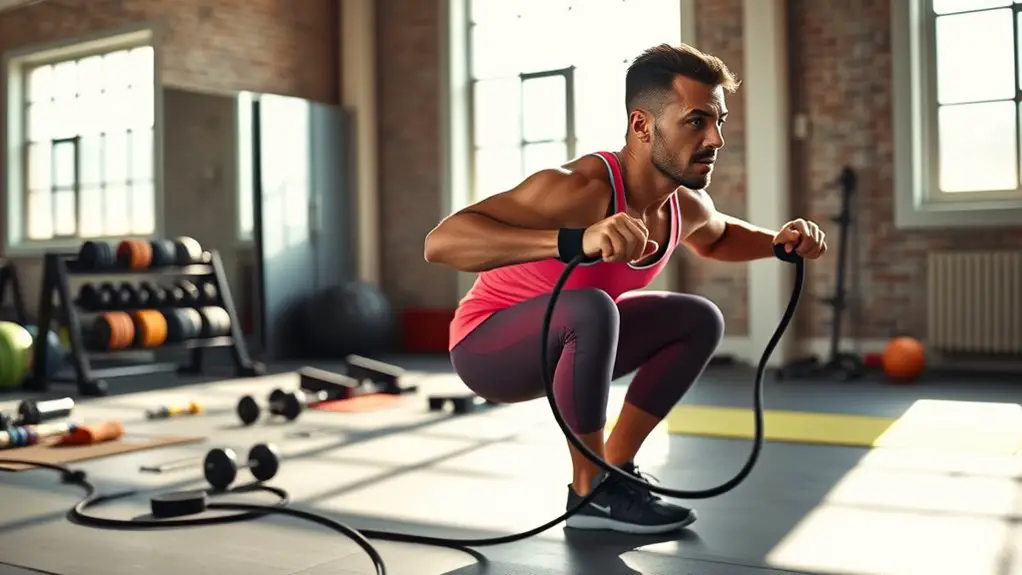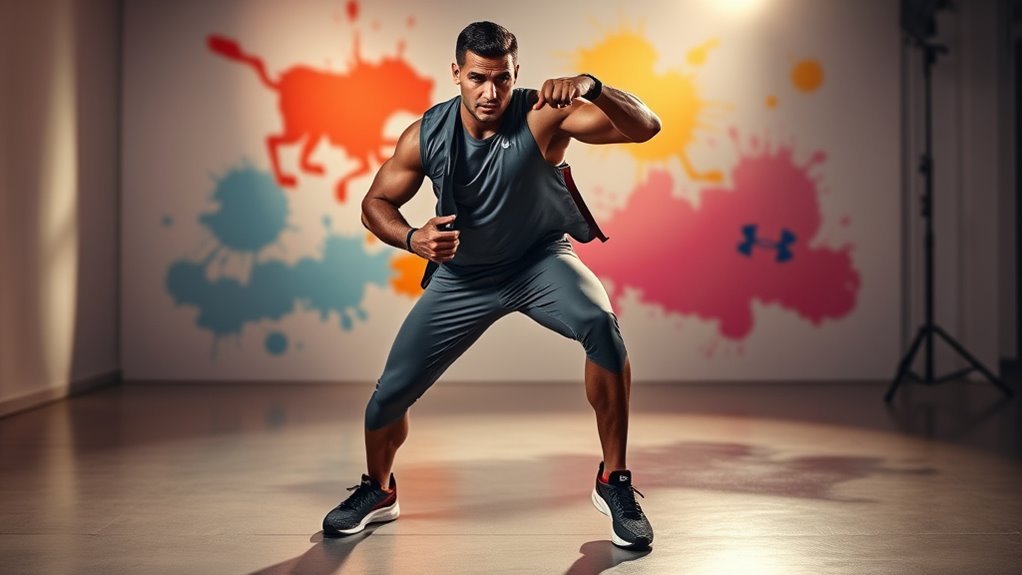Surfing's an underrated full-body workout because it engages your core, arms, shoulders, and legs, building strength and endurance. Balancing on the board enhances your coordination, while paddling boosts your upper body power and cardiovascular fitness. Plus, the endorphin rush from catching waves lifts your mood and connects you with nature. You'll also develop resilience and camaraderie with fellow surfers. There's so much more to discover about the benefits of surfing for your body and mind.
The Core Connection: Strengthening Your Midsection
Your core is essential for mastering surfing, and it's not just about balance. A strong midsection helps you stay stable on your board, allowing you to ride those waves with confidence. Engaging your core keeps your body aligned, making it easier to shift your weight and maneuver through the surf. When you strengthen your core, you reveal a new level of freedom on the water.
Think of it as the powerhouse of your body; every twist and turn in the ocean starts from your midsection. Whether you're paddling out or popping up, a robust core allows for smoother changes and better control. Core strength is crucial for connecting your movements, enabling efficient transitions on the water. Incorporating exercises like planks, sit-ups, and rotations into your routine can make all the difference. So, embrace the journey of strengthening your core, and watch how it transforms your surfing experience. You'll feel more connected to the ocean, enjoying every wave that comes your way.
Upper Body Engagement: Arms, Shoulders, and Back
When you're out on the water, your arms, shoulders, and back play an essential role in your surfing performance. The strength you build through paddling directly translates to your ability to ride waves with confidence. Understanding the dynamics of upper body engagement can enhance your overall surfing experience. Incorporating exercises like the bench press can significantly improve your upper body power, contributing to more effective paddling and wave riding.
Paddle Power Dynamics
As you paddle through the waves, the upper body engages in a powerful symphony of movement, drawing strength from your arms, shoulders, and back. This dynamic action doesn't just propel you forward; it also builds endurance and muscle. Each stroke is a dance, connecting you more deeply with the ocean.
Here's what you're activating:
- Arms: Your biceps and triceps work hard, powering each stroke with precision.
- Shoulders: Engaging your deltoids helps stabilize your movements, allowing for fluidity.
- Back: Your latissimus dorsi and rhomboids contribute to strength and posture, essential for effective paddling.
Embrace this unique workout; it's not just about catching waves but also about feeling alive and free in the water.
Wave Riding Strength
While riding a wave, the upper body must engage in a powerful display of strength and coordination, ensuring you maintain balance and control on the surfboard. Your arms push and pull, guiding your movements as you carve through the water. Shoulders work hard to stabilize your stance, allowing you to shift your weight smoothly. Your back muscles play an essential role in keeping you upright and agile, responding instantly to the wave's rhythm. This dynamic engagement not only helps you ride with finesse but also builds a strong upper body over time. Embracing the freedom of wave riding means harnessing this strength, letting your body flow with the ocean while enjoying an exhilarating full-body workout that few activities can match.
Leg Power: Building Strength and Endurance
Leg power is essential for surfers, not just for paddling out but also for maintaining balance and generating speed on the waves. Strong legs help you carve through the water and react quickly to changing conditions, giving you the freedom to ride the surf like a pro. Here's how you can build that strength and endurance:
Leg strength is crucial for surfers, enhancing balance and speed for a thrilling ride on the waves.
- Squats: They engage your quads, hamstrings, and glutes, mimicking the stance you take on the board.
- Lunges: These improve your stability and mimic the movements needed for shifting weight while surfing.
- Leg Press: This helps build explosive strength, allowing you to push off the board with power.
Incorporating these exercises into your routine will enhance your leg strength, making every wave feel like a smooth ride. Additionally, focusing on plyometric exercises can further improve your explosiveness, giving you an edge in the water. So, get out there, strengthen those legs, and enjoy the freedom of surfing!
Balance and Stability: Enhancing Coordination
To ride the waves like a pro, mastering balance and stability is essential for any surfer. When you're out there, it's all about finding your center and staying grounded, which enhances your coordination. As you paddle and pop up on your board, you're constantly engaging your core and adjusting to the shifting waves. This dynamic movement helps you develop a keen sense of balance, allowing you to carve and ride effortlessly. Additionally, integrating cross-training activities can enhance your core strength, further supporting your surfing performance.
Here's a quick look at how balance and stability come into play:
| Aspect | Impact on Surfing | Training Techniques |
|---|---|---|
| Core Strength | Better stability | Planks, yoga |
| Foot Placement | Improved maneuverability | Balance boards, drills |
| Body Awareness | Enhanced coordination | Surf-specific exercises |
| Flexibility | Greater range of motion | Stretching routines |
Cardiovascular Benefits: A Heart-Pumping Experience
Mastering balance and stability not only enhances your coordination on the board but also sets the stage for an exhilarating cardiovascular workout. When you paddle out and catch those waves, you're engaging your heart and lungs in a way that few activities can match. Surfing gets your blood pumping and elevates your heart rate, all while you're soaking up the sun and enjoying the ocean breeze.
Here's what you can expect from the cardiovascular benefits of surfing:
- Increased endurance: You'll build stamina, making those long sessions on the water feel effortless.
- Improved heart health: Regular surfing strengthens your heart, reducing the risk of cardiovascular issues.
- Calorie burning: It's an awesome way to torch calories while having fun, so you won't even notice you're working out! Additionally, the combination of high-intensity intervals and endurance training can further enhance your overall aerobic capacity while surfing.
Flexibility and Mobility: Stretching Beyond Limits
When you surf, you're not just riding waves; you're also enhancing your muscle elasticity and improving your joint range. This flexibility and mobility play a vital role in your overall performance and injury prevention. Mobility training can further enhance your surfing experience by increasing your range of motion and reducing the risk of injuries. Let's explore how these benefits can take your surfing to the next level.
Enhances Muscle Elasticity
As you paddle out into the waves, your body engages in a dynamic dance that enhances muscle elasticity, essential for maintaining balance and control. This flow not only feels liberating but also helps you push your limits while riding the surf. Here's how surfing boosts your muscle elasticity:
- Dynamic Movements: Each wave requires quick shifts in position, stretching and contracting your muscles, which improves their elasticity.
- Core Engagement: Balancing on your board demands strong core muscles, promoting flexibility as you twist and turn with the water's rhythm.
- Stretching Nature: The act of catching waves naturally involves stretching your arms, legs, and back, enhancing your overall flexibility.
Improves Joint Range
While surfing might seem like just a thrilling pastime, it greatly improves your joint range, allowing for greater flexibility and mobility. As you paddle and balance on your board, your body engages in dynamic movements that stretch and strengthen your joints. You'll find yourself twisting, turning, and bending in ways that enhance your overall range of motion. This increased flexibility not only helps you maneuver better on the waves but also reduces your risk of injury in daily activities. By embracing the freedom of surfing, you're not just riding waves; you're revealing the potential of your body. So, grab your board and ride the swell, knowing that each session is a step toward greater agility and freedom of movement.
Mental Wellness: The Psychological Perks of Surfing
Surfing doesn't just challenge your body; it also offers significant mental health benefits that can enhance your overall well-being. Riding those waves can be a liberating experience, providing a unique escape from daily stresses. You might find that surfing helps you:
Surfing not only tests your physical limits but also provides an empowering escape from stress, enhancing your mental well-being.
- Boost your mood: The rush of catching a wave releases endorphins, offering a natural high that lifts your spirits.
- Enhance your focus: Staying present while traversing the ocean sharpens your mind, promoting mindfulness and clarity.
- Connect with nature: Being in the water fosters a sense of peace and connection, reminding you of the beauty around you.
These psychological perks make surfing more than just a sport; it's a path to mental freedom and resilience. Additionally, engaging in this activity can also help reduce stress levels, allowing you to access your full potential without the burdens of anxiety. So, grab your board and embrace the waves—your mind will thank you for it!
Injury Prevention: Strengthening Through Movement
Injuries can be a surfer's worst nightmare, but you can greatly reduce your risk by strengthening your body through movement. When you engage in surfing, you're not just riding waves; you're also building muscle and improving your flexibility. By focusing on core stability, your balance enhances, making it easier to stay on your board. Incorporate exercises like squats, lunges, and planks into your routine, as they mimic the movements you'll perform while surfing.
Additionally, don't forget to stretch! A flexible body is a resilient one. With regular stretching, you can prevent strains and sprains, allowing you to ride the waves freely. By embracing this dynamic approach to fitness, you'll not only boost your performance but also enjoy longer, injury-free surf sessions. Furthermore, developing grip strength through targeted exercises can significantly enhance your overall stability and control while on the board. So, get moving, strengthen that body, and enjoy the freedom that comes with being fit and ready to conquer the ocean!
Social Interaction: Fitness With a Community Vibe
Strengthening your body not only prepares you for the physical demands of surfing but also opens the door to social connections that enhance your experience in the water. When you hit the waves, you're not just riding the tide; you're joining a vibrant community. Surfing creates bonds that go beyond the ocean, making it a unique way to socialize while working out.
Surfing strengthens your body and connects you to a vibrant community, turning every wave into a social experience.
Here are some ways surfing fosters community:
- Shared Experiences: The thrill of catching a wave brings you closer to fellow surfers, creating unforgettable memories together.
- Supportive Environment: Whether you're a newbie or a pro, you can always find encouragement and tips from others, fostering growth.
- Beach Culture: The laid-back vibe of the surf scene invites camaraderie, making it easy to connect with like-minded individuals. Additionally, engaging in supportive relationships can significantly enhance your confidence, both in and out of the water.
Making Waves: Incorporating Surfing Into Your Routine
Whether you're a seasoned wave rider or just starting out, incorporating surfing into your routine can transform your fitness journey. Surfing isn't just about the thrill of riding waves; it's a full-body workout that engages your core, arms, and legs. Start by carving out time each week to hit the beach—make it a ritual. You don't need perfect waves to reap the benefits; even small swells can help you practice balance and endurance.
Consider blending surfing with other activities. Try yoga for flexibility, or strength training to build muscle. The freedom of the ocean complements these workouts beautifully. Plus, the more you surf, the more you'll connect with nature, enhancing your mental well-being.
Frequently Asked Questions
Can Beginners Surf Effectively for a Full-Body Workout?
Absolutely, you can surf effectively as a beginner! It'll challenge your balance, strength, and endurance. Plus, the thrill of riding waves fuels your spirit, making it a fun way to get fit and enjoy freedom.
How Often Should I Surf to See Fitness Results?
To see fitness results, aim to surf at least two to three times a week. Consistency's key, and you'll soon feel the benefits in your strength, stamina, and overall well-being. Enjoy the ride!
What Equipment Do I Need for Surfing Workouts?
Picture yourself riding waves; you'll need a sturdy surfboard, a wetsuit for warmth, and a leash to keep your board close. Don't forget sunscreen, and maybe a rash guard for extra comfort while you conquer the ocean!
Are There Age Restrictions for Surfing as a Workout?
There aren't strict age restrictions for surfing as a workout. Whether you're young or older, you can enjoy the freedom and thrill of riding waves. Just make sure you're physically prepared and have the right guidance.
How Does Surfing Compare to Other Full-Body Workouts?
Imagine gliding over sparkling waves, your body engaged as you paddle, balance, and ride. Unlike traditional workouts, surfing's rhythm and flow connect you to nature, offering a liberating experience that challenges and strengthens every muscle.




